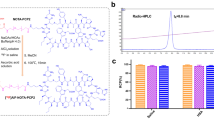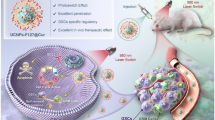Abstract
Glioblastoma multiforme (GBM) is the most common and highly malignant primary brain tumor, which is virtually incurable due to its therapeutic resistance to radiation and chemotherapy. To develop novel therapeutic approaches for treatment of GBM, we examined the role of miR-378 on tumor growth, angiogenesis, and radiation response in ectopic and orthotopic U87 glioblastoma models. Cell and tumor growth rates, in vitro and in vivo radiation sensitivities, and tumor vascular density were evaluated in U87-GFP and U87-miR-378 tumor lines. Ectopic tumor response to radiation was evaluated under normal blood flow and clamp hypoxic conditions. Results show that in vitro, miR-378 expression moderately increased cell growth rate and plating efficiency, but did not alter radiation sensitivity. U87-miR-378 tumors exhibited a higher transplantation take rate than U87-GFP tumors. In vivo, under oxygenated condition, subcutaneous U87-miR-378 tumors receiving 25 Gy showed a tendency for longer tumor growth delay (TGD) than control U87-GFP tumors. In contrast, under hypoxic condition, U87-miR-378 xenografts exhibited substantially shorter TGD than U87-GFP tumors, indicating that under normal blood flow conditions, U87-miR-378 tumors were substantially more oxygenated than U87-GFP tumors. Intracranial multi-photon laser-scanning microscopy demonstrated increased vascular density of U87-miR-378 versus control U87-GFP tumors. Finally, miR-378 increased TGD following 12 Gy irradiation in U87 intracranial xenografts, and significantly prolonged survival of U87-miR-378 tumor-bearing mice (P = 0.04). In conclusion, higher miR-378 expression in U87-miR-378 cells promotes tumor growth, angiogenesis, radiation-induced TGD, and prolongs survival of orthotopic tumor-bearing hosts. Regulation of VEGFR2 by miR-378 significantly increased vascular density and oxygenation in U87 xenografts.






Similar content being viewed by others

References
Binder DC, Davis AA, Wainwright DA (2016) Immunotherapy for cancer in the central nervous system: current and future directions. Oncoimmunology 5:e1082027
Ostrom QT, Gittleman H, Fulop J et al (2015) CBTRUS statistical report: primary brain and central nervous system tumors diagnosed in the United States in 2008–2012. Neuro Oncol 17(Suppl 4):iv1–iv62
Lu-Emerson C, Duda DG, Emblem KE et al (2015) Lessons from anti-vascular endothelial growth factor and anti-vascular endothelial growth factor receptor trials in patients with glioblastoma. J Clin Oncol 33:1197–1213
Stupp R, Mason WP, van den Bent MJ et al (2005) Radiotherapy plus concomitant and adjuvant temozolomide for glioblastoma. New Eng J Med 352:987–996
Suit HD, Zietman A, Tomkinson K et al (1990) Radiation response of xenografts od a human squamous cell carcinoma and a glioblastoma multiform: a progress report. Int J Radiat Oncol Biol Phys 18:365–373
Mukherjee B, McEllin B, Camacho CV et al (2009) EGFRvIII and DNA double-strand break repair: a molecular mechanism for radioresistance in glioblastoma. Cancer Res 69:4252–4259
Chinot OL, Wick W, Mason W et al (2014) Bevacizumab plus radiotherapy-temozolomide for newly diagnosed glioblastoma. New Eng J Med 370:709–722
Chaponis D, Barnes JW, Dellagatta JL et al (2011) Lonafarnib (SCH66336) improves the activity of temozolomide and radiation for orthotopic malignant gliomas. J Neurooncol 104:179–189
Stupp R, Dietrich PY, Ostermann Kralijevic S et al (2002) Promising survival for patients with newly diagnosed glioblastoma mutltiforme treated with concomitant temozolomide. J Clin Oncol 20:1375–1382
Vandamme M, Robert E, Dozias S et al (2011) Response of human glioma U87 xenografted on mice to nonthermal plasma treatment. Plasma Med 1:27–43
Zhang M, Herion TW, Timke C et al (2011) Trimodal glioblastoma treatment consisting of concurrent radiotherapy, temozolomide, and the novel TGF-β receptor I kinases inhibitor LY2109761. Neoplasia 13:537–549
de Groot JF, Fuller G, Kumar A et al (2010) Tumor invasion after treatment of glioblastoma with bevacizumab: radiographic and pathologic correlation in humans and mice. Neuro-Oncology 12:233–242
McLendon R, Friedman A, Bigner D et al (2008) Comprehensive genomic characterization defines human glioblastoma genes and core pathways. Nature 455:1061–1068
Clark MJ, Homer N, O’Connor BD et al (2010) U87MG decoded: the genomic sequence of a cytogenetically aberrant human cancer cell line. PLoS Genet 61:e1000832
Ponten J, Macintyre EH (1968) Long term culture of normal and neoplastic human glia. Acta Pathol Microbil Scand 74:465–486
Huang P, Allam A, Taghian A et al (1995) Growth and metastatic behavior of five human glioblastomas compared with nine other histological types of human tumor xenografts in SCID mice. J Neurosurg 83:308–315
Huang P, Allam A, Perez LA et al (1995) The effect of combining recombinant human tumor necrosis factor-alpha with local radiation on tumor control probability of a human glioblastoma multiforme xenograft in nude mice. Int J Radiat Oncol Biol Phys 32:93–98
Lee C-G, Heijn M, di Tomaso E et al (2000) Anti-vascular endothelial growth factor treatment augments tumor radiation response under normoxic or hypoxic conditions. Cancer Res 60:5565–5570
Yuan F, Salehi HA, Boucher Y et al (1994) Vascular permeability and microcirculation of gliomas and mammary carcinomas transplanted in rat and mouse cranial windows. Cancer Res 54:4564–4568
Winkler F, Kozin SV, Tong RT et al (2004) Kinetics of vascular normalization by VEGFR2 blockade governs brain tumor response to radiation: role of oxygenation, angiopoietin-1, and matrix metalloproteinases. Cancer Cell 6:553–563
Jain RK (2014) Antiangiogenesis strategies revisited: from starving tumors to alleviating hypoxia. Cancer cell 26:605–622
Askoxylakis V, Ferraro GB, Kodack DP et al (2016) Preclinical efficacy of ado-trastuzumab emtansine in the brain microenvironment. J Natl Cancer Inst 108:djv313. doi:10.1093/jnci/div313
Wang J, Klem J, Wyrick JB et al (2003) Detection of hypoxia in human brain tumor xenografts using a modified comet assay. Neoplasia 5:288–296
Timke C, Zieher H, Roth A et al (2008) Combination of vascular endothelial growth factor receptor/platelet-derived growth factor receptor inhibition markedly improves radiation tumor therapy. Clin Cancer Res 14:2210–2219
Zhao D, Stafford, Zhou et al (2011) Near-infrared optical imaging of exposed phosphatidylserine in a mouse glioma model. Trans Oncol 4:355–364
Gole B, Huszthy PC, Popovic M et al (2012) The regulation of cysteine cathepsins and cystatins in human gliomas. Int J Cancer 131:1779–1789
Baumann M, DuBois W, Pu A et al (1992) Responses of xenografts of human malignant gliomas and squamous cell carcinoma to fractionated irradiation. Int J Radiat Oncol Biol Phys 23:803–809
Gray LH, Conger AD, Ebert M et al (1953) The concentration of oxygen dissolved in tissues at the time of irradiation as a factor in radiotherapy. Br J Radiol 26:638–648
Pires IM, Olcina MM, Anbalagan S et al (2012) Targeting radiation-resistant hypoxic tumor cells through ATR inhibition. Br J Cancer 107:291–299
Semenza GL (2004) Intratumoral hypoxia, radiation resistance, and HIF-1. Cancer Cell 5:405–406
Lee DY, Deng Z, Wang C-H, Yang BB (2007) MicroRNA-378 promotes cell survival, tumor growth, and angiogenesis by targeting SuFu and Fus-1 expression. PNAS 104:20350–20355
Deng Z, Yang X, Fang L et al (2013) Misprocessing and functional arrest of microRNAs by mir-pirate: roles of mir-378 and mir-17. Biochem J 450:375–386
Huang Y, Liu X, Wang X (2015) MicroRNA-378 regulates neural stem cell proliferation and differentiation in vitro by modulating Tailless expression. Biochem Biophys Res Commun 466:214–220
Li B, Wang Y, Li S et al (2015) Decreased expression of miR-378 correlates with tumor invasiveness and poor prognosis of patients with glioma. Int J Clin Exp Pathol 8:7016–7021
McMillin DW, Negri JM, Mitsiades CS (2013) The role of tumor-stromal interactions in modifying drug response: challenges and opportunities. Nat Rev Drug Discov 12:217–228
Gerweck LE, Vijayappa S, Kurimasa A et al (2006) Tumor cell radiosensitivity is a major determinant of tumor response to radiation. Cancer Res 66:8352–8355
Huang P, Duda DG, Jain RK, Fukumura D (2008) Histopathologic findings and establishment of novel tumor lines from spontaneous tumors in FVB/N mice. Comp Med 58:253–263
Mucaj V, Lee SS, Skuli N et al (2015) MicroRNA-124 expression counteracts pro-survival stress responses in glioblastoma. Oncogene 34:2204–2214
Joseph JV, Conroy S, Pavlov K et al (2015) Hypoxia enhances migration and invasion in glioblastoma by promoting a mesenchymal shift mediated by the HIF1α-ZEB1 axis. Cancer Lett 359:107–116
Combs SE, Schmid TE, Vaupel P, Multhoff G (2016) Stress responses leading to resistance in glioblastoma: the need for innovative radiotherapy (iRT) concepts. Cancers 8:15. doi:10.3390/cancers8010015
Acknowledgements
We would like to thank the Cox-7 animal care team members for their excellent animal support; Sylvie Roberge, Shanmin Chin, Xiaolong Qi and Mark Badeaux for their technical advice and support; Cissy Huang for her assistance in the preparation of this manuscript. Funding supported was provided by NCI/Federal Share Proton Beam Program Income to P.H. and R.K.J.; P01CA080124 and R01CA163815 to R.K.J.; and the National Foundation for Cancer Research to R.K.J.
Author information
Authors and Affiliations
Corresponding author
Ethics declarations
Conflict of interest
The authors declare that they have no conflict of interest.
Electronic supplementary material
Below is the link to the electronic supplementary material.
Rights and permissions
About this article
Cite this article
Li, W., Liu, Y., Yang, W. et al. MicroRNA-378 enhances radiation response in ectopic and orthotopic implantation models of glioblastoma. J Neurooncol 136, 63–71 (2018). https://doi.org/10.1007/s11060-017-2646-y
Received:
Accepted:
Published:
Issue Date:
DOI: https://doi.org/10.1007/s11060-017-2646-y



